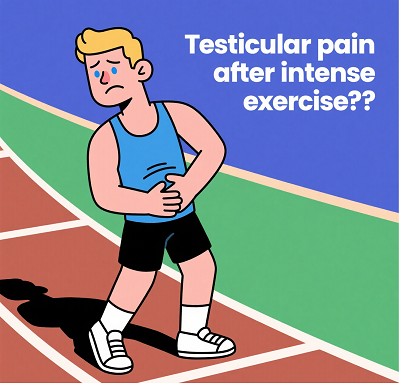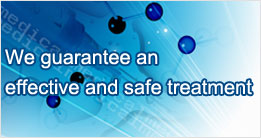Why Your Testicles Hurt After Exercise? Try These Simple At-Home Remedies
Last week after playing basketball, Dicas experienced a dull pain in his groin. He thought it would go away after sleeping, but he was tormented by a dragging sensation in the middle of the night, tossing and turning in discomfort.

Many men have experienced temporary discomfort in the testicular area after intense exercise, but when the pain persists for hours or even longer, that unbearable feeling may hide several potential causes that cannot be ignored. Different causes require different strategies—so are there any relief methods that can be done at home? Let’s analyze the possible causes first.
Possible Causes of Persistent Testicular Pain After Intense Exercise
1. Friction Injury
Friction injury is the most common culprit, especially after cycling or long-distance running. The seams of tight athletic pants repeatedly rub against the delicate skin, causing a burning, stinging pain that makes walking difficult. Don’t underestimate this friction—it can rupture subcutaneous capillaries and, in severe cases, even lead to hematoma formation. Don’t tough it out! Remove the tight pants immediately and apply cold compresses. If swelling persists after two days and you feel a hard lump under the skin, seek medical attention immediately!
2. Epididymitis
Bacterial infections often strike after exercise. You may feel the epididymis swollen like a peanut, tender to the touch, with pain radiating to the groin and a burning sensation during urination. Epididymitis requires prompt antibiotic treatment as prescribed by a doctor to control infection and prevent worsening.
3. Varicocele
Varicocele occurs due to impaired blood flow in the spermatic vein—simply put, a "traffic jam" in the veins supplying the testicles. Normally, it might only cause slight scrotal heaviness, but intense exercise increases blood circulation, intensifying the pain. Mild cases can be managed with lifestyle adjustments, while severe cases may require surgical treatment, such as high ligation of the spermatic vein.
4. Testicular Torsion
Testicular torsion is a medical emergency in which the blood vessels become severely twisted, cutting off the blood supply and causing excruciating pain. If testicular torsion is not treated promptly, it may lead to testicular necrosis and impaired fertility. Immediate surgical intervention, such as orchiopexy (testicular fixation surgery), should be performed.
5. Prostatitis
When the prostate becomes inflamed, the pain may sometimes radiate to the testicular area. Intense exercise can cause prostate congestion, which may induce or exacerbate this referred pain. Doctors will select appropriate antibacterial medications for patients based on the type of pathogen, and patients should also ensure adequate rest and avoid excessive fatigue.
To prevent testicular pain after strenuous exercise, it is recommended to wear proper athletic gear before exercising to avoid unnecessary friction and impact on the testicles, thereby preventing the occurrence of these conditions.
Try These Simple At-Home Remedies for Testicles Hurt After Exercise
After ruling out emergencies that require immediate hospital treatment, the following practical at-home relief techniques may help you get through the difficult period:
1. Physical Relief Methods
Targeted Ice Therapy:
Apply an ice pack wrapped in a towel to the painful area for 15 minutes per session, repeating at 1-hour intervals, with no more than 4 applications on the first day. The low temperature induced by ice therapy causes vasoconstriction, reducing swelling and alleviating pain.
Postural Decompression:
While lying flat, gently elevate the scrotum using a rolled-up towel, or try the "knee-chest position" (kneeling on the bed with the chest pressed against the mattress and buttocks raised). These methods help promote venous return of congested blood and relieve the sensation of heaviness.
Supportive Undergarments
Purchase a specialized, breathable cotton scrotal support band (not tight compression shorts!). It provides testicular support and minimizes movement-induced friction and jostling, significantly improving patient comfort.
2. Medication and Exercise Adjustment
Short-term Medication:
Nonsteroidal anti-inflammatory drugs (NSAIDs) such as ibuprofen can help relieve pain. Many patients also benefit from the Diuretic and Anti-inflammatory Pill, a traditional Chinese herbal remedy known for its anti-inflammatory, antibacterial, and circulation-promoting effects—especially helpful in chronic testicular or pelvic discomfort.
Gentle Exercise:
When experiencing pain, stop intense workouts immediately! Light activities such as walking are acceptable, but movements that compress the perineal area—such as cycling or squats—should be paused without hesitation to allow the body time to recover.
3. Lifestyle Adjustments
Sleep Recovery:
Ensure at least 7 hours of quality sleep. Sleeping posture matters—lying on the back or right side is preferable, and avoid putting pressure on the painful side.
Anti-Inflammatory Diet:
Increase intake of anti-inflammatory foods like tomatoes and salmon. Avoid irritants such as alcohol, chili peppers, and hot pot—they can truly worsen the pain!
Effective Strategies to Prevent Persistent Testicular Pain After Strenuous Exercise
1. Exercise Protection
For high-impact sports involving intense physical contact and frequent jumping—such as soccer and basketball—it is strongly recommended to wear two-piece protective athletic shorts! These typically feature an elastic support pouch that securely stabilizes the testicles, significantly reducing the risk of severe impact and friction.
2. Scientific Warm-up
Before exercising, spend 10 minutes thoroughly warming up, with particular emphasis on stretching the hip joints and pelvic floor muscles. Movements like high-knee walking and lunges with torso rotation are highly effective. Additionally, patients should dedicate 10 minutes daily to specifically stretch the groin area (e.g., seated straddle stretch), which helps reduce tension in the pelvic floor muscles and prevents pain triggered by sudden vigorous activity.
3. Hydration and Recovery
During exercise, do not wait until you feel thirsty to drink. Maintain regular hydration (e.g., approximately 150ml every 20 minutes). Within 30 minutes post-exercise, consume electrolyte-containing beverages (sports drinks or lightly salted water) to help the body more rapidly eliminate "fatigue-inducing substances" (inflammatory factors) produced during exercise, thereby effectively preventing subsequent pain.
Persistent testicular pain acts as the body's alarm system—it should neither be met with excessive panic nor blindly ignored. By mastering scientific home care methods and seeking prompt medical attention when necessary, you can effectively safeguard your health.



